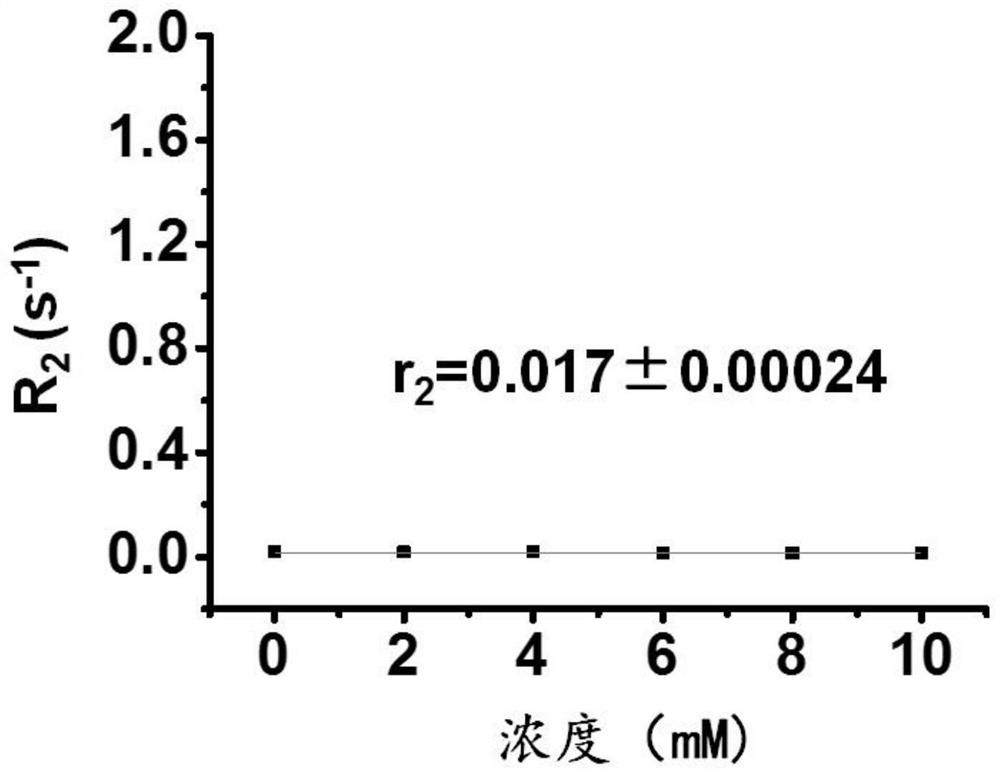A recognition of lysine decarboxylase 129 xe"r 2 "Relaxation switch type" magnetic resonance molecular probe
A lysine decarboxylase and molecular probe technology, which is applied in the field of 129Xe "r2 relaxation efficiency switch type" magnetic resonance molecular probes to achieve high-sensitivity identification and strong penetrability.
- Summary
- Abstract
- Description
- Claims
- Application Information
AI Technical Summary
Problems solved by technology
Method used
Image
Examples
Embodiment 1
[0035] Embodiment 1 measures the relaxation efficiency of ammonium acetate buffer
[0036] (1) Ammonium acetate is dissolved in ultrapure water, and the solutions that are configured into ammonium acetate concentration as 0mM, 2mM, 4mM, 6mM, 8mM, and 10mM are respectively recorded as solution 1, solution 2, solution 3, solution 4, solution 5, Solution 6;
[0037] (2) Each 2 mL of solution 1, solution 2, solution 3, solution 4, solution 5 and solution 6 prepared in the present embodiment was obtained, and the 400MHz magnetic resonance spectrometer was used to 129 In Xe spectrum mode, it is used in conjunction with a hyperpolarized device (the gas heating temperature is 135°C, the gas flow rate is 0.12 standard liters / minute, and the gas composition is 2% Xe, 8% N in volume percentage 2 and 90% He, of which Xe is 26.4% of natural abundance 129 Xe), the experimental temperature is 298K, the test solution 129 T of Xe in solution 1, solution 2, solution 3, solution 4, solution 5...
Embodiment 2
[0038] Embodiment 2 tests the relaxation efficiency of lysine solution
[0039] (1) Get ammonium acetate and be dissolved in ultrapure water, be configured into the solution that ammonium acetate concentration is 10mM, be recorded as solution 1;
[0040] (2) Take 5 parts of lysine and dissolve them in solution 1 respectively, sonicate until the lysine is completely dissolved, and configure the concentration of lysine to be 0.2μM, 0.4μM, 0.6μM, 0.8μM, 1.0μM, and use acetic acid and Ammonia liquor adjusts the pH of solution respectively, makes the pH of solution be 6.0, is recorded as solution 2, solution 3, solution 4, solution 5, solution 6 respectively;
[0041] (3) 2 mL of solution 1, solution 2, solution 3, solution 4, solution 5, and solution 6 prepared in this embodiment are each taken in 2 mL with a 400 MHz magnetic resonance spectrometer 129 In Xe spectrum mode, it is used in conjunction with a hyperpolarized device (the gas heating temperature is 135°C, the gas flow r...
Embodiment 3
[0042] Embodiment 3 measures the relaxation efficiency of lysine decarboxylase solution
[0043] (1) Get ammonium acetate and be dissolved in ultrapure water, be configured into the solution that ammonium acetate concentration is 10mM, be recorded as solution 1;
[0044] (2) Take 4 parts of lysine decarboxylase, dissolve them in solution 1 respectively, configure the concentration of lysine decarboxylase as 0.5μg / mL, 1μg / mL, 1.5μg / mL, 2μg / mL, add acetic acid and ammonia water Adjust the pH of the solution respectively, so that the pH of the solution is 6.0, which are respectively recorded as solution 2, solution 3, solution 4, and solution 5;
[0045] (3) Each 2 mL of solution 1, solution 2, solution 3, solution 4 and solution 5 prepared in the present embodiment was obtained, and the 400MHz magnetic resonance spectrometer was used to 129 In Xe spectrum mode, it is used in conjunction with a hyperpolarization device (the gas heating temperature is 135°C, the gas flow rate is ...
PUM
 Login to View More
Login to View More Abstract
Description
Claims
Application Information
 Login to View More
Login to View More - R&D
- Intellectual Property
- Life Sciences
- Materials
- Tech Scout
- Unparalleled Data Quality
- Higher Quality Content
- 60% Fewer Hallucinations
Browse by: Latest US Patents, China's latest patents, Technical Efficacy Thesaurus, Application Domain, Technology Topic, Popular Technical Reports.
© 2025 PatSnap. All rights reserved.Legal|Privacy policy|Modern Slavery Act Transparency Statement|Sitemap|About US| Contact US: help@patsnap.com



